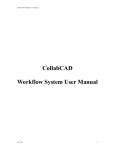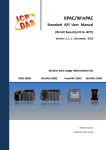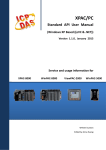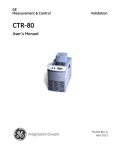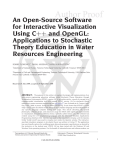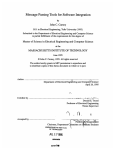Download WM Program manual Amani Tahat, Ali Khwaldeh
Transcript
WM Program manual
1
1
Amani Tahat, 2Ali Khwaldeh, 3Mohammad Tahat
Department of Physics and Nuclear Engineering, Technical University of
Catalonia, Barcelona, Spain
2
Department Of Computer Engineering, Faculty of engineering, Philadelphia University
Amman, Jordan
3
Department of Civil Engineering, New Mexico State University, United State of America
This user manual has been written to describe the open source code WM to be
distributed associated with a research article submitted to the information
technology journal 44124-ITJ-ANSI.entiteled:
“Maintenance and Reengineering of software: Creating a Visual C++ Graphical
User Interface to Perform Specific Tasks Related to Soil Structure Interaction in
Poroelastic Soil “.
1
This manual describes how to run the new produced GUI C++ program that so called
'WM' program. Section two describes the instructions of the program installation.
Section three illustrates test runs description including running the program WM,
sample of the input, output files, in addition to some generated graphs followed by the
main form of the program created by using the Borland C++ Builder 6.
1. Instructions OF Installation
This program is an open source code and available on request from authors. Appendix1
presents the main form of the program created by using the Borland C++ Builder 6. At
least 25 MB of free disk space is required for installing WM on user's computer (PC).
The user needs to execute (SetupWM) file. Setup will create the program's shortcut in the
start menu folder. The selection of different folder could be done by clicking “browse"
then specifying the preferred folder. One or two additional tasks, could be selected to
perform setup while installing WM, setup offers two additional tasks: (1) create a desktop
icon and (2) create a quick lunch icon. After setup has been finished installing WM on
user computer (PC), the application may be launched by selecting the installed icon
(launch WM). But if user select the icon "create a desktop icon" then starting up the
program is performed through traditional windows by clicking on an assigned icon on the
desktop. The program works in a dialog mode through all steps. By choosing an item
from the menu the program opens several available programs in the package. Multi
windows are preserved through the execution of the program. No compilers or
programming language are needed to be installed in PC.
3. Test Runs Description:
2
3.1 Running the Program WM
WM is the main program in this package and it is being used for the organization of all
other programs of this package. The start up of the program is performed using standard
windows possibilities, for example to start using the WM program, user needs to double
click on the icon "WM" after installing it, and then the WM main window will be
appeared, as shown in figure 3.
Figure 3: the WM main window
The main window of the program will be opened as soon as WM program being
executed. This main window contains menu items at the top of the window, the menu
items include Load, CurrentVariant, and help, figure 4 presents menu structure of the
WM program.
Figure 4:- menu structure of the WM package
For running the WM program, user needs to point the option " load" from the "file"
menu, then a window pops up showing the default input files directory, that consists of
one folder called 'samples' which includes the default input file (QQ.dat). The way of
loading the input file is presented in figure 5.
Figure 5: loading the default input file from the default directory (sample).
After loading the input file, WM will produce two windows like those illustrated in
Figure 6; this section provides a full description of these two windows with random
screenshot to explain the way of running WM.
3
Figure 6: The WM main panel windows, which defines the input file and completed with
default values in addition to the plotting window with its plotting menu.
3.1.1
WM Plotter Window
User can switch to use the WM main window, by closing the WM plotter window, as
shown in figure 6. Then the massage "please, press right button mouse" will be appeared
in the plotter window panel. On a mouse right click, the plotting output menu will be
appeared, pointing any option will produce a specific graph based on the stored
calculations that depends on the default input file (QQ.dat) which
consists of two
randomly variants A. Pointing the option “view tables” from the popup menu enabled
viewing the output file. The options of the plotting menu are based on the mode of
calculation that will be discussed in the next section .Figure 7 presents a random example
of such plotting. User can continue viewing the default output by using the tabs (varianA
and variantB), view log button, draw results and “recalc” in addition to draw results
checkboxes.
Figure 7: Random example of using plotting window.
3.1.2
"WM " main window:
Figure 8 presents the main window of the program; it consists of six Input fields and
three checkboxes besides the buttons (view log and variantA, variantB, variantC, “ets”).
Figure 8: main window of the program WM.
4
The input parameters are (eta, n, kf, rhof, anus) plus “iEta” that has two values (1 and 2).
Brief descriptions about the input parameters is available in table 2. Moreover, the input
parameters (e.g. ieta, eta, n, rhof, anus) detailed descriptions can be found in section
(2.3.2) of reference (Al Rjoub, 2007).
Table 2:- description of the input parameters.
The main window presents three checkboxes: "iSealed", "iSeepage", in addition to
"Recalc & Draw results", thus, permits making multiple selections from a number of
options. Normally, white space (for false) or a tick mark (for true), as illustrated in figure
8. It is clear now how the new produced GUI has linked the separated Fortran programes to
be work in one station. iSeald presents the fortran code of (Todorovska and Al Rjoub,
2006a,b) and iSeepage presents the new development of this code based on (Al Rjoub,
2007).
Each checkbox has a caption help for describing the meaning of the check box. Inverting
the state of a check box is done by clicking the mouse on the box. Switching to the mode
of calculations can be done by using the two checkboxes ( iseapage and iseal ) easily. In
the meantime, the output results can be drawn by pointing checkbox (draw result).
Furthermore, user can easily view the output file by clicking the button “view log”. A new
checkbox will be appeared when adding a new variant, namely called ( “recalc & draw
results”). One of the main purposes of the fortran code (SSI_POROUS) of (Todorovska
and Al Rjoub, 2006 b) calculations was to generate data in order to draw graphs for several
5
cases depending mainly on changing the frequency values, if the apparent building –
foundation- soil system frequency changes due to water saturation the analysis begins with
understanding how the wave velocities depend on frequency (eta) and on the soil
permeability (for fixed value of viscosity of the fluid), which will help in, interpreting the
results for the foundation stiffness and damping of (Al Rjoub, 2007). Moreover, the
FORTRAN computer program was written in terms of dimensionless parameters defined
using as reference: length a, material modulus μs, and mass density Pgr as explained in
section 1.2 then the solution of the problem was expressed entirely in terms of
dimensionless parameters, in order to control the system response (Al Rjoub, 2007).
The user of the WM program must be familiar with the theoretical background of the
Fortran program (SSI_POROUS) of (Todorovska and Al Rjoub, 2006 a,b) that will
simplify inserting the specified input data depending on the studying case conditions in
order to generate the expected reflection coefficient (Al Rjoub, 2007).
WM program provides a very simple way for managing that. User has to start with filling
his variants (A, B, C, D….etc) files and give it a comment following his studying case.
WM used these variants instead of using input files in order to allow understanding the
whole matter in one work station; user can save all variants in one input file, where the
default input file includes two variants A and B. Figure 9 presents the location of the
(variants, comment filed) in the main window, the user comment will be appeared in the
output file.
Figure 9: the fields (Variant and comment).
6
User has several input parameters that need to be specified. Sometimes the case study is
due to fixing some parameters so that user can generate so many curves each one differs
from the other by changing one parameter at each time.
For this purpose user can “delete” or “clone” more variants depending on the
preconditions of the specified case study. This can be done by pointing the option “clone”
or "Delete" from the “CurrentVariant " menu, as presented in figure 10. Then user can
continue deleting until deletes all variants to restart the WM program by inserting the
default input file QQ.dat for adding new variants.
Figure 10: the “currentVariant” menu.
WM program provides two modes of calculation and they are:
1. The default mode (Al Rjoub, 2007) : computing the coefficient of reflection for
incident plane p-wave and sv-wave (P fast , P slow and S waves [coef Pf , coefPs ,
coefSh ] from free – half space surface when the seepage force is:
Included in the analysis: by clicking the mouse on the ' checkbox "
'iseapage "then to click the checkbox (recalc & draw results).
Not included in the analysis: user needs to repeat the previous steps but to
invert the state of a check box, user must click the mouse on the checkbox
'" iseapage ".
In both cases WM program will produce the WM plotter window automatically, user can
close this window in order to view the output file by clicking the button "view log'.
7
The output window provides four services, save as, copy and paste available on the
popup menu that appears on clicking the right key of the mouse. Figure 11 presents the
two output files.
Figure 11: presents the two output files.
WM allows file manipulations. Thus, it provides viewing and plotting capabilities of the
produced data, after inserting the variants (A, B, C, etc) and calculating the desired output
file, users can generate graphic plots of data extracting from a specific output file. Figure
12 presents an example of plotting curves as those of (Al Rjoub, 2007) , to illustrate a
chart of normalized wave velocities of the mixture for different values of permeability
and for fixed value porosity = 0.4 and frequency (eta) = 2HZ. WM program can extract
data from the stored database (output file), for plotting output data and displaying the
required graphic through the WM plotter window in a matter of seconds. User can plot
the two graphs one above the other at the same distance scale, with different colors to
allow distinguishing them, furthermore, WM can generate several curves in the same
graph not only two graphs depending on the conditions of the case study. This helps in
drawing many plots with arguments that have been set the function of this program to
include drawing plots and saving them as a graphic files, the user may use the right key
of mouse to download the plot in clipboard, this allows pasting the plot in any data file,
moreover, the program works in a dialog mode until it is being closed.
Figure 12: Example of plotting, the coefficient of reflection (Al Rjoub, 2007) for (P fast ,
P slow and S waves [coef Pf , coefPs , coefSh ] from free – half space surface when the
seepage force is included, versus angle of incident waves of the mixture for different
8
values of permeability and for fixed value porosity and frequency (eta),user can continue
adding curves by using the plotting menu.
The status bar of the “WMplotter” window presents the values of variants (A, B, C…etc)
that are located in the y axes and the values of the x axes (e.g., the angle of incident
wave). The values of (X, Y) can be read by moving the curser on the specified curve, see
figure 13.
Figure 13: the status bar of the window "Plotter": show current Value for nearest Graph
(from cursor position).
By selecting the option “view tables” from the plotting menu, WM will generate the
source file of the currently plotting data, for example if user choose to plot (coefast,
coefslow and coesh) versus the angle of incident wave “I” (degree), the option view
tables will generate the output file that appears in figure 14, following the specified
variants, if user used 2 variants A and B then selecting the option “view tables”
will
generate two different output files see figure 15.
Figure 14: source data files (output) when using variantA only.
Figure 15: the two source data files (output) when using variantA and variantB.
2. Second mode of calculations: involve computing the coefficient of waves
reflected from a homogeneous poroelastic halfspace for incident plane p-fast
9
wave and sealed as well as unsealed boundaries. Besides the computing of the
coefficient of waves reflected from a homogeneous poroelastic halfspace for
incident plane SV wave and sealed as well as unsealed boundary to be included in
the same output file. That will be generated in this step all when clicking the
“isealed “checkbox or not. For more clarifications, this can be done by clicking
the mouse on the checkbox “isealed" for the case (sealed boundary) then to click
the checkbox (recalc & draw results). User needs to repeat the previous steps to
invert the state of a check box for the case (unsealed boundary) so user must click
the mouse on the checkbox '" isealed'. In the two cases WM program will produce
the WM plotter window automatically; user can close this window in order to
view the output file by pressing the button "view log”. In this case user can
continue using the “Wmplotter “ window for computing:
The reflection coefficients for incident unit displacement plane p-wave
and sealed boundary and,
The reflection coefficient for incident unit displacement plane SV- wave
and sealed boundary
Herein, user has to select the option (file displace.out) from the plotting
menu then the option ( cabs(uux)) to generate number of curves depending
on the number of the input variants(A,B,C…etc). See figure 16.
Figure 16:- the angle of the incident wave versus (cabsuux ) for two variant (A and B).
User can view the output file by using the option “view tables” in the same way that has
been discussed in the previous section. On the other hand, in order to compute the
following:
10
The reflection coefficients for incident unit displacement plane p-wave
and unsealed boundary.
The reflection coefficients for incident unit displacement plane SV-wave
and unsealed boundary.) User has to select the option (cabs (uuz)) from the
plotting window appeared in figure 16.
When checking the output file, it could be found that it consists of all expected values,
that has been discussed above, the reflection coefficients appears in series way (A
,B,C,….etc ) depending on the number of the input variants(A,B,C….etc) for example
from figure 17, the C_INC_S=(1.1555887 , 0.0000000E+0) means that the reflection
coefficient for incident unit displacement plane SV- wave (sealed boundary) equals to
1.1555887 and so on for all output values.
Figure17: Output file contents example.
Finally the plotting menu provides two additional options under the title ( file stresses.out
), with different submenus this part is to check the functions for ( u_r, u_th ,tau_tt.. etc )
in polar coordinates for integral of stresses along the contact surface all details are
included in reference (Todorovska and Al Rjoub,2006) in addition to (Al Rjoub, 2007)
study. See figure 18 and 19. User can control this from the input parameter ( iEta) that
has two values (1 and 2)
For i_eta= 1 user receives the output
cabs (tau_zz),cabs(tau_xz),cabs(tau_xx),cabs(sigma).
11
For i_eta= 2 user receives the output cabs (tau_xx), cabs(sigma) ,cabs(tau_xz).
Figure 18: How to select the option (file stress. out) menus.
Figure 19: Output, the option (file stress. out) menus.
WM generates six output files with
extension "out", and they are (check, cofec1,
freq_cof , freq_disp, stresses, and displace) in order to extract the plotting data following
the user needs, all these files stored in the default directory (samples), in the same time.
Figures legends
Figure 1: The GUI of the program Adope Photoshop
Figure 2: The simple two-dimensional soil-structure interaction model
Figure 3: the WM main window
Figure 4:- menu structure of the WM package
Figure 5: loading the default input file from the default directory (sample).
Figure 6: The WM main panel windows, which defines the input file and completed with
default values in addition to the plotting window with its plotting menu.
Figure 7: Random example of using plotting window.
Figure 8: main window of the program WM.
Figure 9: the fields (Variant and comment).
12
Figure 10: the “currentVariant” menu.
Figure11: presents the two output files.
Figure 12: Example of plotting, the coefficient of reflection for (P fast , P slow and S
waves [coef Pf , coefPs , coefSh ] from free – half space surface when the seepage force
is included, versus angle of incident waves of the mixture for different values of
permeability and for fixed value porosity and frequency (eta),user can continue adding
curves by using the plotting menu
Figure 13: the status bar of the window "Plotter": show current Value for nearest Graph
(from cursor position).
Figure 14: source data files (output) when using variantA only.
Figure 15: the two source data files (output) when using variantA and variantB.
Figure 16:- the angle of the incident wave versus (cabsuux ) for two variant(A and B).
Figure17: Output file contents example.
Figure 18: How to select the option (file stress. out) menus.
Figure 19: Output, the option (file stress. out) menus.
Figures list
13
Figure 1: The GUI of the program Adope Photoshop
Figure 2: The simple two-dimensional soil-structure interaction model
14
Figure 3: the WM main window
15
Figure 4:- menu structure of the WM package
Figure 5: loading the default input file from the default directory (sample).
16
Figure 6: The WM main panel windows, which defines the input file and completed with
default values in addition to the plotting window with its plotting menu.
17
Figure 7: Random example of using plotting window.
18
Figure 8: main window of the program WM.
Figure 9: the fields (Variant and comment).
19
Figure 10: the “currentVariant” menu.
20
Figure11: presents the two output files.
21
Figure 12: Example of plotting, the coefficient of reflection for (P fast , P slow and S
waves [coef Pf , coefPs , coefSh ] from free – half space surface when the seepage force
is included, versus angle of incident waves of the mixture for different values of
permeability and for fixed value porosity and frequency (eta),user can continue adding
curves by using the plotting menu.
22
Figure 13: the status bar of the window "Plotter": show current Value for nearest Graph
(from cursor position).
23
Figure 14: source data files (output) when using variantA only.
24
Figure 15: the two source data files (output) when using variantA and variantB.
25
Figure 16:- the angle of the incident wave versus (cabsuux ) for two variant(A and
B).
26
Figure17: Output file contents example.
27
Figure 18: How to select the option (file stress. out) menus.
Figure 19: Output, the option (file stress. out) menus
Appendix1: WM Main Form Created by using Borland C++ Builder 6.
//---------------------------------------------------------------------------
28
#include <vcl.h>
#include <stdio.h>
#include <process.h>
#pragma hdrstop
#include "frmMain.h"
#include "frmAbout.h"
#include "frmGraph.h"
#include "Results.h"
#include "frmViewLog.h"
//--------------------------------------------------------------------------#pragma package(smart_init)
#pragma resource "*.dfm"
TFormMain *FormMain;
//--------------------------------------------------------------------------TFormGraph *TFormMain::NewFormGraph() {
if (pFormGraph) return pFormGraph;
pFormGraph = new TFormGraph(this);
pFormGraph->sFileVariantsFullName = ExpandFileName(sFileVariants);
return pFormGraph;
}
bool flIgnoreChangeEvent = false;
29
//--------------------------------------------------------------------------__fastcall TFormMain::TFormMain(TComponent* Owner) : TForm(Owner) {
pFormGraph = NULL;
}
//--------------------------------------------------------------------------void __fastcall TFormMain::FormCreate(TObject *Sender) {
SetModifyVariants(false);
OpenDialogInputVasues->InitialDir = ExtractFileDir(_argv[0]);
InitParams();
#ifdef _DEBUG
const char * pFileVariants = "Samples\\QQ.dat";
VariantsLoadFromFile(pFileVariants);
#endif
}
//--------------------------------------------------------------------------void __fastcall TFormMain::mmHelpClick(TObject *Sender) {
TFormAbout *frm = new TFormAbout(this);
frm->ShowModal();
delete frm;
30
}
//--------------------------------------------------------------------------struct ParamInfo {
const char * pParamName;
void * pParamControl;
int sms;
};
//--------------------------------------------------------------------------class InputValues {
public:
InputValues();
~InputValues() {
delete pResults;
}
AnsiString sVariantIdent;
AnsiString sVariantComment;
double n;
double eta;
double kf;
double rhof;
double anus;
31
double viscosity;
//? double j;
double permeabil;
int i_sealed,i_seepage,i_eta;
int iDrawGraph;
int GetSMS(void * pMember) const { return (char*)pMember - (char*)this; }
void SetAsDouble(int sms, const AnsiString &s) {
double *p = (double *) (((char*)this) + sms);
sscanf(s.c_str(),"%lg",p);
}
void SetAsCheckBox(int sms, const AnsiString &s) {
int *p = (int*) (((char*)this) + sms);
sscanf(s.c_str(),"%d",p);
}
void SetAsComboBox(int sms, const AnsiString &s) {
int *p = (int*) (((char*)this) + sms);
sscanf(s.c_str(),"%d",p);
}
void ToDialogParamDouble (const ParamInfo *piEdt) const;
void ToDialogParamDoubleAll
32
(const ParamInfo *piEdt) const;
void ToDialogParamCheckBox
(const ParamInfo *piChB) const;
void ToDialogParamCheckBoxAll (const ParamInfo *piChB) const;
void ToDialogParamComboBox
(const ParamInfo *piCoB) const;
void ToDialogParamComboBoxAll (const ParamInfo *piCoB) const;
void FromDialogParamDouble
(const ParamInfo *piEdt);
void FromDialogParamDoubleAll
(const ParamInfo *piEdt);
void FromDialogParamCheckBox
(const ParamInfo *piChB);
void FromDialogParamCheckBoxAll(const ParamInfo *piChB);
void FromDialogParamComboBox (const ParamInfo *piCoB);
void FromDialogParamComboBoxAll(const ParamInfo *piCoB);
void SaveVariant(FILE *out) const;
int CreateTempInputFile(const char *fnameIn, int mode, AnsiString &fnameInTmp)
const;
Results *pResults;
}; //end class InputValues
//--------------------------------------------------------------------------InputValues::InputValues() {
n
=0.3;
eta
=1;
kf
=1;
33
rhof
=0.3;
anus =0.3;
viscosity = 1e-8;
// j = 1;
permeabil = 1;
i_sealed
= 0;
i_seepage
= 1;
i_eta
= 0;
iDrawGraph = 0;
pResults = NULL;
} //end InputValues::InputValues
//---------------------------------------------------------------------void InputValues::SaveVariant(FILE *out) const {
fprintf(out, "\n//-------------------------------------------");
fprintf(out, "\nVariantIdent=%s", sVariantIdent.c_str());
fprintf(out, "\nVariantComment=%s", sVariantComment.c_str());
fprintf(out, "\neta=%lg"
, eta);
fprintf(out, "\nkf=%lg"
, kf);
fprintf(out, "\nrhof=%lg"
, rhof);
34
fprintf(out, "\nanus=%lg"
, anus);
fprintf(out, "\nn=%lg"
, n);
fprintf(out, "\nviscosity=%lg"
, viscosity);
fprintf(out, "\npermeabil=%lg"
, permeabil);
//?fprintf(out, "\nj=%lg"
, j);
fprintf(out, "\ni_sealed=%d" , i_sealed);
fprintf(out, "\ni_seepage=%d"
fprintf(out, "\ni_eta=%d"
, i_seepage);
, i_eta);
fprintf(out, "\n");
fprintf(out, "\niDrawGraph=%d"
, iDrawGraph);
fprintf(out, "\n");
} //end InputValues::SaveVariant
//---------------------------------------------------------------------int InputValues::CreateTempInputFile(const char * fnameIn, int mode, AnsiString
&fnameInTmp) const {
if (mode<1 || mode>2) return 1;
const char *modeName[] = {NULL,"~SEE-REF.txt","~REF_COF.txt"};
fnameInTmp = ChangeFileExt(fnameIn,modeName[mode]);
35
FILE *out = fopen(fnameInTmp.c_str(),"wt");
if (!out) return 2;
if (mode==1) {
fprintf(out, "%lg %lg %lg %lg\n", n, kf, rhof, anus);
fprintf(out, "%lg ", viscosity);
//fprintf(out, " %lg\n", j);
fprintf(out, "%d %d %d\n", i_sealed, i_seepage, i_eta);
fprintf(out, "\n");
fprintf(out, "\n// n, kf, rhof, anus");
fprintf(out, "\n// viscosity, j");
fprintf(out, "\n// i_sealed, i_seepage, i_eta");
}
else
if (mode==2) {
fprintf(out, "%lg %lg %lg %lg %lg\n", n, eta, kf, rhof, anus);
fprintf(out, "%lg %lg\n", viscosity, permeabil);
fprintf(out, "%d %d %d\n", i_sealed, i_seepage, i_eta);
fprintf(out, "\n");
fprintf(out, "\n// n, eta, kf, rhof, anus");
fprintf(out, "\n// viscosity, permeabil");
fprintf(out, "\n// i_sealed, i_seepage, i_eta");
}
fclose(out);
36
return 0;
} //end InputValues::CreateTempInputFile
//--------------------------------------------------------------------------void InputValues::ToDialogParamDouble(const ParamInfo *piEdt) const {
double *p = (double *) (((char*)this) + piEdt->sms);
AnsiString s;
s.printf("%lg",*p);
TEdit *pEdt = (TEdit *) piEdt->pParamControl;
pEdt->Text = s;
}
void InputValues::ToDialogParamDoubleAll(const ParamInfo *piEdt) const {
for(; piEdt->pParamName; piEdt++) {
ToDialogParamDouble(piEdt);
}
}
//--------------------------------------------------------------------------void InputValues::ToDialogParamCheckBox(const ParamInfo *piChB) const {
int *p = (int *) (((char*)this) + piChB->sms);
TCheckBox *pCheckBox = (TCheckBox *) piChB->pParamControl;
pCheckBox->Checked = *p;
}
void InputValues::ToDialogParamCheckBoxAll(const ParamInfo *piChB) const {
for(; piChB->pParamName; piChB++) {
ToDialogParamCheckBox(piChB);
37
}
}
//--------------------------------------------------------------------------void InputValues::ToDialogParamComboBox(const ParamInfo *piCoB) const {
int *p = (int *) (((char*)this) + piCoB->sms);
AnsiString sp = IntToStr(*p);
TComboBox *pComboBox = (TComboBox*) piCoB->pParamControl;
for(int i=0; i<pComboBox->Items->Count; i++) {
String ss = pComboBox->Items->Strings[i];
if (ss==sp) {
pComboBox->ItemIndex = i;
return;
}
}
pComboBox->ItemIndex = -1;
}
void InputValues::ToDialogParamComboBoxAll(const ParamInfo *piCoB) const {
for(; piCoB->pParamName; piCoB++) {
ToDialogParamComboBox(piCoB);
}
}
//--------------------------------------------------------------------------void InputValues::FromDialogParamDouble(const ParamInfo *piEdt) {
38
TEdit *pEdt = (TEdit *) piEdt->pParamControl;
AnsiString s = pEdt->Text;
double *p = (double *) (((char*)this) + piEdt->sms);
sscanf(s.c_str(),"%lg",p);
}
//--------------------------------------------------------------------------void InputValues::FromDialogParamDoubleAll(const ParamInfo *piEdt) {
for(; piEdt->pParamName; piEdt++)
FromDialogParamDouble(piEdt);
}
//--------------------------------------------------------------------------void InputValues::FromDialogParamCheckBox(const ParamInfo *piChB) {
TCheckBox *pCheckBox = (TCheckBox *) piChB->pParamControl;
int *p = (int *) (((char*)this) + piChB->sms);
*p = pCheckBox->Checked;
}
//--------------------------------------------------------------------------void InputValues::FromDialogParamCheckBoxAll(const ParamInfo *piChB) {
for(; piChB->pParamName; piChB++)
FromDialogParamCheckBox(piChB);
}
//--------------------------------------------------------------------------void InputValues::FromDialogParamComboBox(const ParamInfo *piCoB) {
39
TComboBox *pComboBox = (TComboBox*) piCoB->pParamControl;
int *p = (int *) (((char*)this) + piCoB->sms);
if (pComboBox->ItemIndex>=0)
*p = StrToInt(pComboBox->Text);
}
//--------------------------------------------------------------------------void InputValues::FromDialogParamComboBoxAll(const ParamInfo *piCoB) {
for(; piCoB->pParamName; piCoB++)
FromDialogParamComboBox(piCoB);
}
//--------------------------------------------------------------------------ParamInfo *FindParam(ParamInfo *PI, const AnsiString &sParamName) {
for(; PI->pParamName; PI++) {
if (sParamName==PI->pParamName)
return PI;
}
return NULL;
}
//--------------------------------------------------------------------------void TFormMain::ClearFields() {
EdtPorosity
->Text = "";
EdtFrequencyEta
->Text = "";
EdtFluidCompressibilityKf->Text = "";
40
EdtDensityFluidRhof ->Text = "";
EdtPoissonRatioAnus
->Text = "";
EdtViscosity
->Text = "";
EdtPermeability
->Text = "";
}
//--------------------------------------------------------------------------//--------------------------------------------------------------------------typedef DynamicArray <ParamInfo> DynamicArrayParamInfo;
ParamInfo *ParamInfoEdt = NULL;
ParamInfo *ParamInfoChB = NULL;
ParamInfo *ParamInfoCoB = NULL;
//--------------------------------------------------------------------------void AddParam(DynamicArrayParamInfo &daParamInfo, const char * pParamName,
void * pParamControl, int ParamSms) {
ParamInfo &pi = daParamInfo[daParamInfo.Length++];
pi.pParamName
= strdup(pParamName);
pi.pParamControl= pParamControl;
pi.sms
= ParamSms;
}
//--------------------------------------------------------------------------ParamInfo *MoveParams(DynamicArrayParamInfo &daParamInfoTmp) {
const int nP = daParamInfoTmp.Length;
ParamInfo *pPI = new ParamInfo[nP+1];
41
ParamInfo *p = pPI;
for(int i=0; i<nP; i++) {
const ParamInfo &pi = daParamInfoTmp[i];
*p++ = pi;
}
p->pParamName = NULL;
p->pParamControl = NULL;
p->sms = 0;
daParamInfoTmp.Length = 0;
return pPI;
} //end MoveParams
//--------------------------------------------------------------------------void TFormMain::InitParams() {
DynamicArrayParamInfo daParamInfoTmp;
InputValues d;
AddParam(daParamInfoTmp,"n"
,d.GetSMS(&d.n));
,EdtPorosity
AddParam(daParamInfoTmp,"eta"
,d.GetSMS(&d.eta));
,EdtFrequencyEta
AddParam(daParamInfoTmp,"kf"
,d.GetSMS(&d.kf));
,EdtFluidCompressibilityKf
AddParam(daParamInfoTmp,"rhof"
,d.GetSMS(&d.rhof));
,EdtDensityFluidRhof
AddParam(daParamInfoTmp,"anus"
,d.GetSMS(&d.anus));
,EdtPoissonRatioAnus
42
AddParam(daParamInfoTmp,"viscosity"
,d.GetSMS(&d.viscosity));
,EdtViscosity
AddParam(daParamInfoTmp,"permeabil"
,d.GetSMS(&d.permeabil));
,EdtPermeability
ParamInfoEdt = MoveParams(daParamInfoTmp);
AddParam(daParamInfoTmp,"i_sealed"
,d.GetSMS(&d.i_sealed));
,CheckBoxSealed
AddParam(daParamInfoTmp,"i_seepage"
,d.GetSMS(&d.i_seepage));
,CheckBoxSeepage
AddParam(daParamInfoTmp,"iDrawGraph" ,CheckBoxDrawGraph
,d.GetSMS(&d.iDrawGraph));
ParamInfoChB = MoveParams(daParamInfoTmp);
AddParam(daParamInfoTmp,"i_eta" ,ComboBoxIEta
,d.GetSMS(&d.i_eta));
ParamInfoCoB = MoveParams(daParamInfoTmp);
} //end TFormMain::InitParams
//--------------------------------------------------------------------------void TFormMain::VariantsLoadFromFile(const char * pFileVariants) {
if (TabControllVariants->Tabs->Count<=0) SetModifyVariants(false);
FILE *in = fopen(pFileVariants,"rt");
if (!in) {
43
sFileVariants = "";
return;
}
InputValues *pIV = NULL;
char buf[1000];
for(;;) {
char * p = fgets(buf, sizeof(buf)-1, in);
if (!p) break;
while(*p==' ' || *p=='\t') p++;
if (*p=='/') continue; // - comment
char *e = p;
for(; *e; e++) {
if (strchr(" \t=",*e)) break;
}
if (*e=='\0') continue;
char *v;
if (*e=='=') v = e+1;
else {
v = strchr(e,'=');
if (!v) continue;
44
v++;
}
*e = '\0';
AnsiString sParamName
= AnsiString(p).Trim();
AnsiString sParamValue
= AnsiString(v).Trim();
if (sParamName=="VariantIdent") {
pIV = new InputValues();
pIV->sVariantIdent = sParamValue;
AddTab(pIV);
continue;
}
if (sParamName=="VariantComment") {
pIV->sVariantComment = sParamValue;
continue;
}
//if (sParamName=="n") {
// String as="";
//}
if (!pIV) continue;
ParamInfo *pPI = FindParam(ParamInfoEdt, sParamName);
if (pPI) {
45
pIV->SetAsDouble(pPI->sms, sParamValue);
//pIV->ToDialogParamDouble1(pPI);
continue;
}
pPI = FindParam(ParamInfoChB, sParamName);
if (pPI) {
pIV->SetAsCheckBox(pPI->sms, sParamValue);
continue;
}
pPI = FindParam(ParamInfoCoB, sParamName);
if (pPI) {
pIV->SetAsComboBox(pPI->sms, sParamValue);
continue;
}
//? Unknown Param
} //end for
fclose(in);
sFileVariants = pFileVariants;
Caption = AnsiString("WM - ") + sFileVariants;
// Draw On LoadFile variants
int isDraw = 0;
46
const int nV = TabControllVariants->Tabs->Count;
for(int i=0; i<nV; i++) {
InputValues *pIV = (InputValues *) TabControllVariants->Tabs->Objects[i];
if (!pIV->iDrawGraph) continue;
if (!pIV->pResults) Recalc(pIV);
isDraw |= (int) pIV->pResults;
} //end for
if (isDraw) {
if (!pFormGraph) pFormGraph = NewFormGraph(); // new TFormGraph(this);
pFormGraph->UpdateGraphData();
pFormGraph->BringToFront();
}
InputValuesSetToForm(pIV);
} //end TFormMain::VariantsLoadFromFile
//--------------------------------------------------------------------------void TFormMain::VariantSaveToFile(const char * pFileVariants) {
int nV = TabControllVariants->Tabs->Count;
if (nV<=0) return;
AnsiString sFileBAK = ChangeFileExt(AnsiString(pFileVariants),".bak");
unlink(sFileBAK.c_str());
rename(pFileVariants,sFileBAK.c_str());
47
FILE *out = fopen(pFileVariants,"wt");
if (!out) return;
for(int i=0; i<nV; i++) {
const InputValues *pIV = (const InputValues *) TabControllVariants->Tabs>Objects[i];
pIV->SaveVariant(out);
} //end for
fclose(out);
SetModifyVariants(false);
sFileVariants = pFileVariants;
} //end TFormMain::VariantSaveToFile
//--------------------------------------------------------------------------void TFormMain::InputValuesSetToForm(const InputValues *pIV) {
if (!pIV) {
// ???
ClearFields();
return;
}
flIgnoreChangeEvent = true;
EdtVariantIdent
->Text = pIV->sVariantIdent;
EdtVariantComment ->Text = pIV->sVariantComment;
48
pIV->ToDialogParamDoubleAll
(ParamInfoEdt);
pIV->ToDialogParamCheckBoxAll (ParamInfoChB);
pIV->ToDialogParamComboBox
(ParamInfoCoB);
SetCaptions(pIV->pResults);
flIgnoreChangeEvent = false;
} //end TFormMain::InputValuesSetToForm
//--------------------------------------------------------------------------void TFormMain::InputValuesGetFromForm(InputValues *pIV) {
if (!pIV) return;
pIV->sVariantIdent = EdtVariantIdent
pIV->sVariantComment
->Text;
= EdtVariantComment
->Text;
pIV->FromDialogParamDoubleAll (ParamInfoEdt);
pIV->FromDialogParamCheckBoxAll(ParamInfoChB);
pIV->FromDialogParamComboBoxAll(ParamInfoCoB);
} //end TFormMain::InputValuesGetFromForm
//--------------------------------------------------------------------------void TFormMain::AddTab(InputValues *pIV) {
TabControllVariants->Tabs->Add(pIV->sVariantIdent);
int TabIndex = TabControllVariants->Tabs->Count-1;
TabControllVariants->Tabs->Objects[TabIndex] = (TObject*) pIV;
SetTabIndex(TabIndex);
49
}
//--------------------------------------------------------------------------void TFormMain::SetTabIndex(int TabIndex) {
TabControllVariants->Visible = TabControllVariants->Tabs->Count > 0;
if (TabIndex>=0) {
TabControllVariants->TabIndex = TabIndex;
const InputValues *pIV = (const InputValues *) TabControllVariants->Tabs>Objects[TabIndex];
InputValuesSetToForm(pIV);
} else {
TabControllVariants->TabIndex = -1;
ClearFields();
}
}
//--------------------------------------------------------------------------void __fastcall TFormMain::TabControllVariantsChanging(TObject *Sender, bool
&AllowChange) {
if (TabControllVariants->TabIndex<0) return;
InputValues *pIV = (InputValues *) TabControllVariants->Tabs>Objects[TabControllVariants->TabIndex];
InputValuesGetFromForm(pIV);
// flIgnoreChangeEvent = true;
}
//--------------------------------------------------------------------------50
void __fastcall TFormMain::TabControllVariantsChange(TObject *Sender) {
SetTabIndex(TabControllVariants->TabIndex);
// flIgnoreChangeEvent = false;
if (pFormGraph) {
pFormGraph->Invalidate();
if (CheckBoxDrawGraph->Checked) pFormGraph->Show();
this->BringToFront();
}
}
//--------------------------------------------------------------------------void __fastcall TFormMain::mmCurrentVariantClick(TObject *Sender) {
bool en = TabControllVariants->TabIndex >= 0;
mmCurrentVariantDelete
->Enabled = en;
mmCurrentVariantClone
->Enabled = en;
}
//--------------------------------------------------------------------------void __fastcall TFormMain::mmCurrentVariantCloneClick(TObject *Sender) {
if (TabControllVariants->TabIndex<0) return;
const InputValues *pIVSrc = (const InputValues *) TabControllVariants->Tabs>Objects[TabControllVariants->TabIndex];
InputValues *pIVDest = new InputValues();
*pIVDest = *pIVSrc;
pIVDest->pResults = NULL;
pIVDest->sVariantIdent += "~Clone";
51
AddTab(pIVDest);
SetModifyVariants(true);
}
//--------------------------------------------------------------------------void __fastcall TFormMain::mmCurrentVariantDeleteClick(TObject *Sender) {
// TabControllVariants->Tabs->Clear();
int TabIndex = TabControllVariants->TabIndex;
if (TabIndex<0) return;
InputValues *pIV = (InputValues *) TabControllVariants->Tabs->Objects[TabIndex];
TabControllVariants->Tabs->Delete(TabIndex);
delete pIV;
if (TabIndex>=TabControllVariants->Tabs->Count) TabIndex = TabControllVariants>Tabs->Count-1;
SetTabIndex(TabIndex);
SetModifyVariants(true);
}
//--------------------------------------------------------------------------void __fastcall TFormMain::mmLoadClick(TObject *Sender) {
OpenDialogInputVasues->Filter = "Input files (*.dat)|*.dat|All files (*.*)|*.*|";
if (!OpenDialogInputVasues->Execute()) return;
VariantsLoadFromFile(OpenDialogInputVasues->FileName.c_str());
}
52
//--------------------------------------------------------------------------void __fastcall TFormMain::mmExitClick(TObject *Sender) {
Close();
}
//--------------------------------------------------------------------------void __fastcall TFormMain::File1Click(TObject *Sender) {
bool enSave = isModifyVariants && !sFileVariants.IsEmpty() && TabControllVariants>Tabs->Count>0;
mmSave->Enabled = enSave;
bool enSaveAs = TabControllVariants->Tabs->Count>0;
mmSaveAs->Enabled = enSaveAs;
}
//--------------------------------------------------------------------------void __fastcall TFormMain::mmSaveClick(TObject *Sender) {
VariantSaveToFile(sFileVariants.c_str());
}
//--------------------------------------------------------------------------void __fastcall TFormMain::mmSaveAsClick(TObject *Sender) {
SaveDialogInputVasues->Filter = "Input files (*.dat)|*.dat|All files (*.*)|*.*|";
if (!SaveDialogInputVasues->Execute()) return;
VariantSaveToFile(SaveDialogInputVasues->FileName.c_str());
}
53
//--------------------------------------------------------------------------void __fastcall TFormMain::EdtVariantIdentChange(TObject *Sender) {
if (TabControllVariants->TabIndex<0) return;
TabControllVariants->Tabs->Strings[TabControllVariants->TabIndex] =
EdtVariantIdent->Text;
if (!flIgnoreChangeEvent) SetModifyVariants(true);
}
//--------------------------------------------------------------------------void __fastcall TFormMain::EdtVariantCommentChange(TObject *Sender) {
if (!flIgnoreChangeEvent) SetModifyVariants(true);
}
//--------------------------------------------------------------------------void __fastcall TFormMain::OnChangeInputValues(TObject *Sender) {
if (flIgnoreChangeEvent) return;
if (TabControllVariants->TabIndex<0) return;
SetModifyVariants(true);
InputValues *pIV = (InputValues *) TabControllVariants->Tabs>Objects[TabControllVariants->TabIndex];
if (pIV->pResults) {
delete pIV->pResults;
pIV->pResults = NULL;
//? if (pIV->iDrawGraph) pIV->iDrawGraph = 0;
//? if (pFormGraph) pFormGraph->Invalidate();
}
54
SetCaptions(pIV->pResults);
}
//--------------------------------------------------------------------------typedef int (*tdCalculation)(int mode, char * fnameInTmp, char * fnameOut, char *
folderOut);
tdCalculation pFunCalculation = NULL;
//--------------------------------------------------------------------------void GetProcAddresses() {
static HMODULE hModuleDll = NULL;
if (hModuleDll) return;
AnsiString sDllFullName = ExtractFileDir(_argv[0]) + "\\WM.dll";
hModuleDll = ::LoadLibrary(sDllFullName.c_str());
pFunCalculation = (tdCalculation) GetProcAddress(hModuleDll, "Calculation");
}
//--------------------------------------------------------------------------AnsiString LoadTextFile(const char * pFileName) {
FILE *in = fopen(pFileName,"rt");
if (!in) return "Error !";
AnsiString s;
char buf[1000];
for(;;) {
char * p = fgets(buf, sizeof(buf)-1, in);
if (!p) break;
55
s += AnsiString(p).TrimRight() + "\r\n";
}
fclose(in);
return s;
}
//--------------------------------------------------------------------------void TFormMain::Recalc(InputValues *pIV) {
static int nv=1;
if (nv) {
nv=0;
GetProcAddresses();
if (!pFunCalculation) {
Application->MessageBoxA("Couldn't load DLL", NULL, MB_OK);
return;
}
}
if (!pFunCalculation) return;
AnsiString sInputFileName = sFileVariants;
if (sInputFileName.IsEmpty()) sInputFileName = _argv[0];
sInputFileName = ExpandFileName(sInputFileName);
AnsiString fnameOut = ChangeFileExt(sInputFileName,"~Log.txt");
AnsiString folderOut = ExtractFileDir(fnameOut) + "\\";
56
AnsiString fnameInTmp;
int mode = 2;
int ret = pIV->CreateTempInputFile(sInputFileName.c_str(), mode, fnameInTmp);
if (ret) {
AnsiString msg;
msg.printf("Error N %d on Create Temp Input File\r\n\"%s\"", ret,
fnameInTmp.c_str());
MessageBox(this, msg.c_str(), NULL, MB_OK);
return;
}
Screen->Cursor = crHourGlass;
Application->ProcessMessages();
try {
pFunCalculation(mode, fnameInTmp.c_str(), fnameOut.c_str(),
folderOut.c_str());
} catch(...) {
}
// VerifyButtonsEnabled();
// OnBtnViewOutputLogFile();
delete pIV->pResults;
Results *pResults = pIV->pResults = new Results();
57
pResults->nPoints =
ReadGraphData(folderOut+"cofec1.out"
, &pResults->pX , &pResults->pC1,
&pResults->pC2, &pResults->pC3, NULL);
ReadGraphData(folderOut+"displace.out" , NULL, &pResults->pD1, &pResults>pD2, NULL, NULL);
if (pIV->i_eta==1) {
ReadGraphData(folderOut+"stresses.out" , NULL, &pResults->pS1,
&pResults->pS2, &pResults->pS3, &pResults->pS4);
} else {
ReadGraphData(folderOut+"stresses.out"
&pResults->pS32, &pResults->pS33, NULL);
, NULL, &pResults->pS31,
}
pResults->sLogInfo = LoadTextFile(fnameOut.c_str());
#ifdef _DEBUG
bool flDeleteFiles = false;
// flDeleteFiles = true;
#else
bool flDeleteFiles = true;
#endif
if (flDeleteFiles) {
unlink(fnameInTmp.c_str());
unlink(fnameOut.c_str());
//
58
DeleteFile(folderOut+"cofec1.out");
//
DeleteFile(folderOut+"displace.out");
//
DeleteFile(folderOut+"stresses.out");
//
DeleteFile(folderOut+"freq_cof.out");
//
DeleteFile(folderOut+"freq_disp.out");
//
DeleteFile(folderOut+"check.out");
// - ُç
}
Screen->Cursor = crDefault;
Application->ProcessMessages();
} //end TFormMain::Recalc
//--------------------------------------------------------------------------void __fastcall TFormMain::CheckBoxDrawGraphClick(TObject *Sender) {
if (flIgnoreChangeEvent) return;
if (TabControllVariants->TabIndex<0) return;
// - ???
InputValues *pIV = (InputValues *) TabControllVariants->Tabs>Objects[TabControllVariants->TabIndex];
pIV->iDrawGraph = CheckBoxDrawGraph->Checked;
if (CheckBoxDrawGraph->Checked) {
if (!pIV->pResults) {
InputValuesGetFromForm(pIV);
Recalc(pIV);
59
SetCaptions(pIV->pResults);
if (!pIV->pResults) return;
}
if (!pFormGraph) pFormGraph = NewFormGraph(); // new TFormGraph(this);
}
if (pFormGraph) {
pFormGraph->UpdateGraphData();
//pFormGraph->BringToFront();
}
}
//--------------------------------------------------------------------------void __fastcall TFormMain::FormCloseQuery(TObject *Sender, bool &CanClose) {
if (!isModifyVariants) return;
// Confirm:
AnsiString msg = "Save changes to file\n\"" + sFileVariants + "\"" ;
int ret = Application->MessageBoxA(msg.c_str(), NULL,
MB_YESNOCANCEL|MB_ICONQUESTION); // MB_ICONWARNING
if (ret==IDNO) return;
if (ret==IDYES) {
VariantSaveToFile(sFileVariants.c_str());
}
if (ret==IDCANCEL || isModifyVariants) {
60
CanClose = false;
return;
}
}
//--------------------------------------------------------------------------const Results *GetResults(int &indResults, bool * pflActive, AnsiString *psVariantIdent,
AnsiString *psVariantComment) {
int nV = FormMain->TabControllVariants->Tabs->Count;
for(int i=indResults; i<nV; i++) {
const InputValues *pIV = (const InputValues *) FormMain>TabControllVariants->Tabs->Objects[i];
if (!pIV->iDrawGraph || !pIV->pResults) continue;
indResults = i;
if (pflActive)
*pflActive = i == FormMain->TabControllVariants->TabIndex;
if (psVariantIdent)
*psVariantIdent = pIV->sVariantIdent;
if (psVariantComment)
*psVariantComment = pIV->sVariantComment;
return pIV->pResults;
}
return NULL;
}
//--------------------------------------------------------------------------61
void __fastcall TFormMain::BtnViewLogFileClick(TObject *Sender) {
if (TabControllVariants->TabIndex<0) return;
// - ???
const InputValues *pIV = (const InputValues *) TabControllVariants->Tabs>Objects[TabControllVariants->TabIndex];
if (!pIV->pResults) {
BtnViewLogFile->Enabled = false;
return;
}
if (pIV->pResults->pFormViewLog) {
if (pIV->pResults->pFormViewLog->WindowState==wsMinimized)
pIV->pResults->pFormViewLog->WindowState = wsNormal;
else
pIV->pResults->pFormViewLog->Show();
} else {
pIV->pResults->pFormViewLog = new TFormViewLog(this);
AnsiString sVariant = pIV->sVariantIdent + " ("+pIV->sVariantComment+")";
pIV->pResults->pFormViewLog->Caption = "Log: " + sVariant;
pIV->pResults->pFormViewLog->Memo1->Text =
"// File:\t\"" + ExpandFileName(sFileVariants) +
"\"\r\n// Variant:\t" + sVariant + "\r\n\r\n" + pIV->pResults->sLogInfo;
pIV->pResults->sLogInfo = "";
pIV->pResults->pFormViewLog->RecommendedFileName =
ChangeFileExt(ExpandFileName(sFileVariants), "."+pIV->sVariantIdent+".txt");
pIV->pResults->pFormViewLog->Show();
62
}
}
//--------------------------------------------------------------------------#ifdef _DEBUG
#endif
//---------------------------------------------------------------------------
63































































